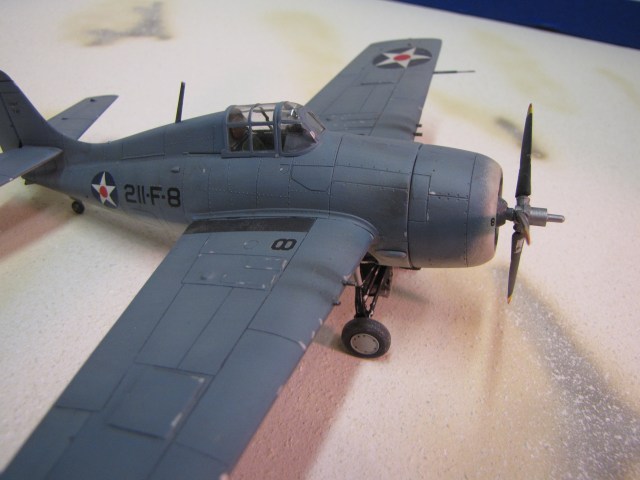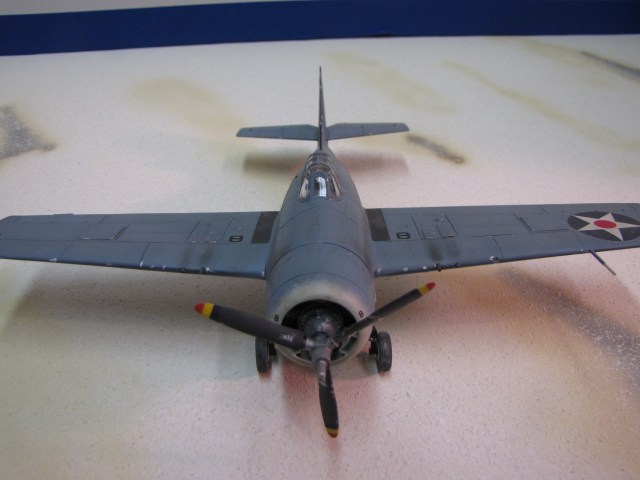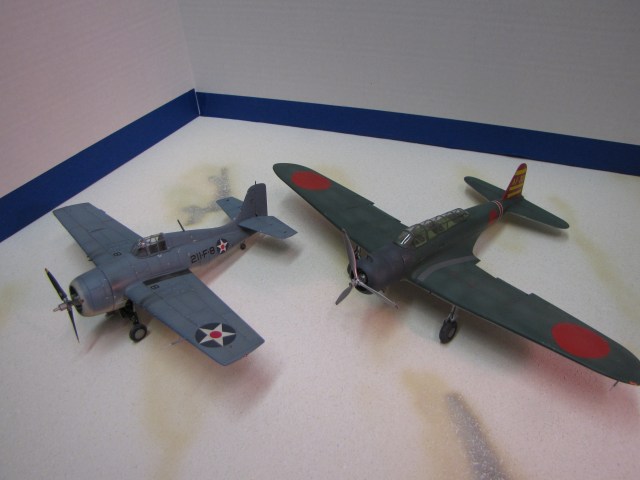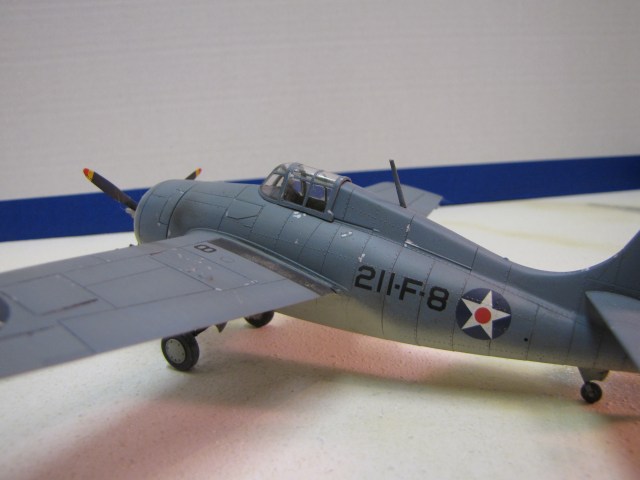Wake Island
Japan started the Pacific War with an explosive campaign of conquest and attack from Malaysia to Pearl Harbor. For the allies, it was almost entirely bad news. One of the few bright spots in those first few months of the war was the stubborn defense of Wake Island.
After the jump, one of the defenders of that tiny atoll.
Wake was part of string of American bases across the Pacific. It is just over 1000 miles from Midway, and slightly further to Guam. It has no indigenous population, and first became meaningful late in the 19th century as a telegraph station for the trans-oceanic cable. In the 1930s it acquired additional importance as a lay over for Pan Am Airlines on their routes connecting the west coast of the United States to The Philippines and China.

A photo of Wake Island taken during the February 1942 air raid by the USS Enterprise. This is a TBD Devastator that had just dropped its two 500 lb bombs.
When Japan went to war, they made a priority of severing that line by capturing Wake and Guam. Guam fell quickly. But Wake had been reinforced, starting several months earlier. There were 388 Marines of the 1st Marine Defense Battalion, plus Naval medical and technical personnel. Then in December of 1941, 12 Wildcats of VMF-211 (“Marine Fighting 211”) were flown in from the USS Enterprise. This delivery mission assured that the Enterprise was not in Pearl Harbor that first Sunday of December.

Overhead view shows the wing, which is a defining trait of the F4F-3 Wildcat. Unlike later models, it does not have a wing fold (for carrier storage). This feature became important as it was learned that MORE FIGHTERS were always needed on a carrier.
It also only has two .50s in each wing. The next model would have three, with less ammunition to save weight. Navy pilots considered this a design flaw. Four .50s were plenty against Japanese aircraft, and less ammunition was bad! The change was requested by the British, who used eight guns in their fighters, and didn’t quite believe that the M2 .50 had about four times the kinetic energy of their own MGs.
Another big identifying trait is the large square panels outboard of the guns. This is for flotation devices (rubberized air bags) that would deploy if the airplane hit the water. This idea was actually abandoned early in Wildcat construction, but the panels remained until the next variant.
On the first day of the war (December 8 on Wake, being on the other side of the International Date Line) the defenders of Wake were not caught asleep. But they had no radar, and no revetments for planes on the ground. So when a standing patrol of four Wildcats missed the incoming Japanese, seven of the eight remaining planes were destroyed on the ground. The surviving five planes would not miss again. In the next two weeks they scored possibly 20 kills before they lost the last of their planes.
The first Japanese invasion attempt was on December 11. The Japanese assumed Wake had been neutralized by three days of heavy bombing. The Marines held fire until Japanese cruisers and destroyers closed to 4000 yds. This was considered point blank range, which the Marines desired since many of their shore batteries didn’t have range finders. When they did open fire, it would be the only time in World War Two when an amphibious assault was defeated by shore based artillery. The destroyer Hayate was sunk by one of the first salvos, and several other ships were seriously damaged. VMF-211 scrambled four planes when the guns opened fire, they attacked with bombs and machine gun fire. Capt Hank Elrod became the first man in history to sink a warship with a fighter type aircraft when he hit and sank the destroyer Kisaragi.
This battle gave rise to another of those persistent myths that are hard to erase. Coded radio messages routinely have extra words and phrases inserted known as “padding” to increase complexity. Apparently when Pearl Harbor inquired what the island’s status was after the battle, the phrases “send us” and “more Japs” were inserted as padding. Somehow this was leaked to the press (perhaps not accidentally! Some one had have kept the padding and deleted the message!) and it was widely distributed as a symbol of defiance. Post war, the surviving defenders were shocked to discover something they had never meant to say was regarded as part of their story.
A relief force was assembled, built around the carriers Enterprise and Lexington, with more fighters and troops. But when intelligence revealed a new Japanese invasion force was also closing on the island, the rescue mission was canceled. CincPAC (Commander in Chief, Pacific. Admiral Pye) was unwilling to risk two carriers after the losses at Pearl Harbor, for an island considered expendable. Apparently talk in the task force turned mutinous, and the mission nearly went forward regardless of orders.

A Medal of Honor was awarded to Capt. Hank Elrod for shooting down four aircraft, sinking a destroyer, and leading ground troops against the second Japanese invasion attempt leading to his death in action.
Had the mission continued, it would have arrived on December 23, during the second Japanese invasion. The defenders fought until their heavy artillery was spent, they were running low on ammunition, they knew their relief had been canceled, and communications were cut off. They apparently killed about 700 Japanese for 50 losses.
In addition to surviving Navy and Marine personnel, the Japanese captured civilian workers who had been hired by the Navy to upgrade the island’s defenses and airfield. After the military personnel were evacuated to POW camps, the civilians remained behind to finish the construction work for the Japanese. When the work was complete, the 98 civilians were executed.

IJN Kisaragi
The fate of civilian workers on Wake Island led to the Navy organizing militarized Construction Battalions, known as “SeaBees”. These workers received basic combat and survival training; to better protect themselves, and get whatever additional protection may come from being in uniform.
This Wildcat is from the Tamiya F4F-4 kit with Superscale decals. It was backdated to an F4F-3 with the conversion set by Just Plane Stuff. I found this a pretty simple build, even with the conversion. Which is funny because the conversion set seems to have a poor reputation. I’ve seen it criticized for fit, texture and detail. But it all works well for me. It seemed to fit well; the texture is slightly different than the kit’s, but not noticeably so under a coat of paint; and the detail complaints strike me as silly. The panels over the wing machine guns, and flotation bags are perhaps raised too proud of where they would be on the actual aircraft. But again, under paint and weathering, I think the “defect” is barely noticeable.
A more recent photo of the island. It was a lot less developed in 1941, but the airfield is in the same place.
The only real complaint I would have is the cost of buying a Tamiya kit and the conversion. But the wing of the -3 Wildcat is very different from the -4 the kit is meant to represent. So several years back when I bought a couple of these sets, I felt I had no other choice if I wanted to avoid scratch building that I believe is beyond me. More recently, the Chinese company Hobby Boss released a full kit of the F4F-3. This is cheap, and definitely the more practical way to go. But, I have built the FM-2 version of this kit and found numerous problems with it. It was not a fun project. I think the conversion will remain the preferred way to go for me, unless Tamiya eventually releases a F4F-3.

A Japanese photo taken after their occupation of the island, showing the remains of VMF-211. Of note, the camouflage directives had changed shortly before the squadron shipped out for Wake, adding blue-gray to the upper surfaces of the previously all gray aircraft. This squadron carries a unique application that left a gray band of color all around the cowl ring. If you’ve seen the Wildcat on display at The Air and Space Museum in DC, you have probably seen the cowl ring shown right here on F-11. The part, believed to be from this airplane, was recovered post war and wound up in the Smithsonian’s collection. When the Wildcat was being restored for display, it was decided to use the Wake Island cowl ring on it.
Up Next: Kubelwagen Type 82






Great job! I just got some good pics of the Wildcat that was recovered from Lake Michigan.
Oh yeah, you were at the Air Zoo! I think they’re only doing that one as a static display, but a couple of those wrecks have been restored to flight. There’s an F4F-3 that flies on the warbird circuit that was restored at the Air Zoo. My wife took a picture of it several years ago that’s now the only airplane allowed in our living room!
F4F-3 planes on Wake deserve to be remember.
Definitely. I think only three of the pilots survived the fight and the POW experience. So no doubt, their sacrifice was great.
I have a couple of things I found that didn’t quite fit in to the text above.
On the morning of December 8, the Japanese actually “destroyed” all eight Wildcats that were on the ground. But one was made functional by piecing it together from the eight wrecked planes. So I just shortened it to say seven were destroyed. Definitely good quality ground crew!
But apparently they struggled with keeping four functional planes for several days, until their numbers started wearing down due to damage and lack of supplies.
Also, best surviving records indicate it was “F-11”, the plane in the foreground of the photo above, that Hank Elrod flew on his famous attack on the Kisaragi. The aircraft was damaged, beyond repair, on that mission. But of course, as I mentioned in the caption, its cowl ring remains at the Air and Space Museum.
I came across an old article that had a picture of the mounted cowl ring on the original memorial on Wake Island.It describes the cowl ring as being from aircraft #9. However, going by the intercooler inlet positions, the cowl ring was mounted upside down on the memorial. Blowing the picture up, a faded #9 is visible, but being upside down it would really be #6.
The cowling is no longer on the Smithsonian Wildcat, but on loan to different museums thru the USMC Museum. I asked them about the number discrepency. The curator agreed that based on that photo it may indeed be from #6 and they would investigate it further.
Interesting. Do you know when it was removed from the Smithsonian? I’m just curious if I’ve seen it or not!
And I take it that means its considered USMC property not Smithsonian property. That is consistent with normal Navy policy on these things, but somehow I didn’t expect it to effect the Smithsonian.
When I wrote the USMC Museum curator, it was August of 2013. He didn’t say when they got the cowl ring back from the Smithsonian, but only that the cowl ring and the prop were currently on loan to the Evergreen Air Museum.
If you’d like to send me your E-Mail address I can send you the photo (very rough) and the reply from the USMC Museum
I’m fortunate that I have the autographs of three of the Wake Island VMF-211 pilots; Kinney, Webb and Kliewer.
Interesting sidenote:
In the early fifties, the US Navy hired a Japanese scrap company to “clean up” Wake Island. Along with other “scrap”, the hulks of the F4F Wildcats loaded onto a transport and hauled away to Japan.
Why is it human nature not to see the historical importance of something until it is gone?
Wow. Those ironies just amaze me too. But it is remarkable that no one (?) appreciated what those Wildcats meant.
That’s a pretty significant set of autographs to have! Were they at an event together or did you get them individually?
At least someone had the wisdom to save Col Olds F-4 Phantom.
The autographs; they’re in good company on my wall — Jimmy Doolittle, Paul Tibbits, Joe Foss, Gabby Gabraski, RL Scott, Tex Hill, Ken Taylor and Robin Olds.
I also have Lloyd M Bucher, captain of the USS Pueblo; a unappreciated hero!
Got them individually; researched organizations that would forward mail to them, requesting an autograph with a return enveloped and the US Mail did the rest.
By the way, I got chatting so much I forgot —- VERY NICE replica of VMF-211 Wildcat!
That’s an impressive collection of autographs! Very cool.
Thanks about the model. I see enough very expert work to know I’m not among the very best; but I have fun, and I love bringing these subjects to life in this way.
Don’t sell yourself short.
Yeah, I’ve seen models built by experts, but if you look long enough, you’ll find either a detail mistake or a build flaw. The expert modeler doesn’t broadcast the mistakes, but a modeler like you — for fun — is the first to admit mistakes in their work and tries to do better on the next one.
Your Wildcat may not be the absolute miniature of the real thing; like you pointed out, the wing access panels may stand too proud, but when I see it I know it’s a F4F-3 (and not an F4F-3A!),of VMF-211, on Wake Island, during December of 1941.
How much more life can you bring into it then that!
Would an “expert” model with the exact number and type of rivets convey anymore then you have?
You just keep building for fun and putting life into plastic —- and sharing them with us!
Well thanks, that’s exactly what I set out to do!
Reblogged this on My Forgotten Hobby and commented:
Dave’s third build of Tamiya’s rendition of the Wildcat.
Great work on the model, and a wonderful article. I have one thing to add…VMF-211 on Wake faced off against Nell bombers (December 8th) and Mavis flying boats (the remaining raids), not Kates, based on the three or four books I’ve read about Wake. But that is a trifling point.
Of course that’s correct for the first several days, but when Carrier Division II paid a visit it would have Kates and Vals.
Thanks for the kind words Darryl!
BTW, love the gravatar!
The only thing I have to question is the color you have used for the upper surfaces. The blue color you have used may be inaccurate. The color scheme you used didn’t come into official use until early 1942. The story I learned about it was that the painting crew mixed up the light neutrality grey with some black paint on USS Enterprise to get a darker grey color for the upper surfaces. That is the color I would like to see on my model, if I can get one together and done.
Accurate color is so hard to be sure of in any sense! I’ve looked at the best available color photography from the period and I know what the painting directives called for (Blue-Gray was usually a mix). But things only gradually got more standardized as the War progressed, even then a lot of adaption and improvisation occurred.
But blue-gray over gray was ordered in November 1941. No doubt the VMF-211 Wildcats were painted in whatever the Enterprise was able to come up with. I would expect some form of sea blue would be available for mixing. But its impossible to know for certain, even impossible to know if they were all painted with the same mix or even with the same colors in the mix. But I have “Aircraft Films” 2-disc set of color Wildcat footage that include some gorgeous sections of Wildcats and Buffalos training in November 1941 in vivid blue. I always remember that when I think of blue-gray aircraft, the color can be very striking.
Ultimately when you build your own you can show it exactly how you want, whether you think your choice is completely correct or its something more speculative just because you want see how it looks (I did a very purple Aleutian Rufe, even though we can be pretty sure at this point such a thing never existed, but aircrew reported them winter of ’42/’43, so I had to see one myself!) If you are pretty sure of a source you can even present it as something you think is accurate, even if it flies in the face of “conventional wisdom”. There were reports of orange painted Vals at Pearl Harbor, one of these days I need to do that too…
Thanks for your detailed response to my notes. I wrote it because I have seen the information written in one of the most recent books on the defense of Wake Island- The title of which escapes, just now.
Anything is possible! But look closely at the source, at this point very few are left alive who ever saw such things and memories can be fickle things. One thought that occurred to me was that the Atlantic ASW scheme was indeed medium gray over white. So it may be that someone who later served on an Atlantic based carrier confused which colors they used when. Multiple witnesses, documentation and good photos make for the best sources (much better than old memories), but in the end you make your best guess.
I would be interested in seeing your VMF-211 Wildcat in two shades of gray! And hey, Eduard just released a gorgeous F4F-3 kit, best we’ve ever had.
I’m enjoying this conversation! The source I mentioned also discussed how the unique cowl lip division of colors came to be. I am just sorry I don’t remember that book title.
Awesome! I always enjoy discussion of these things… which may be why my wife is happy for this website!
I have a few charts that show how all the pre-War yellow wings markings work. It was quite sophisticated, you can identify any airplane to its squadron, section and place in formation if you’re in to the heraldry of it.
But I don’t think I’ve seen an accounting of how it came about. I would love to know if you remember that book name!